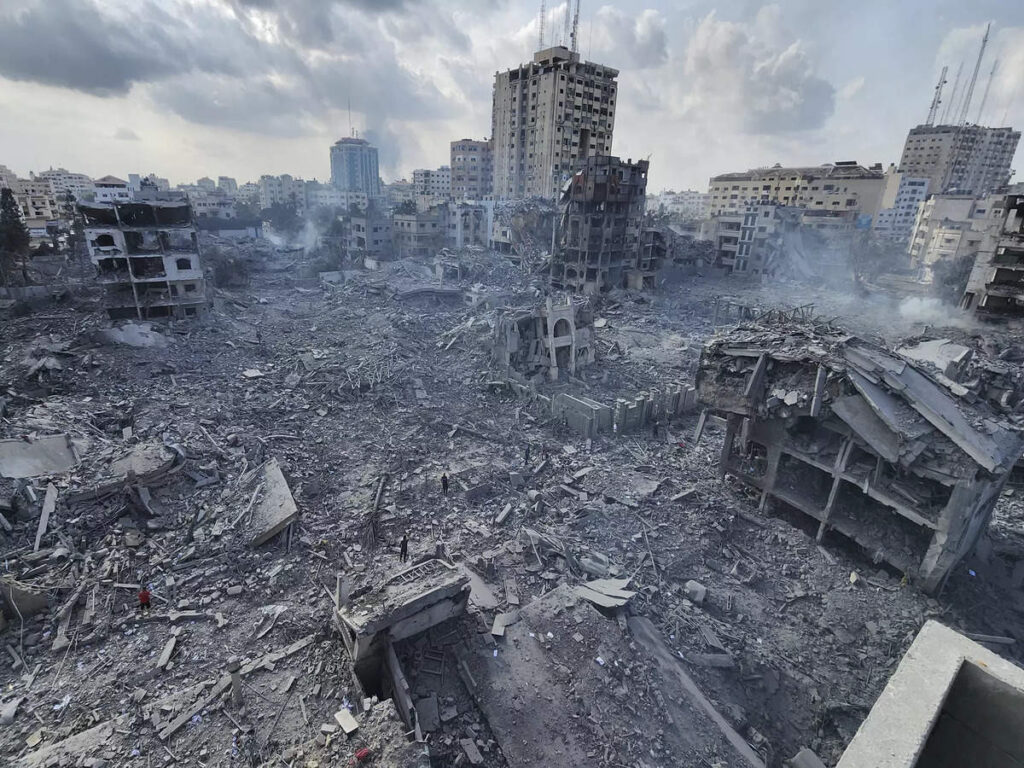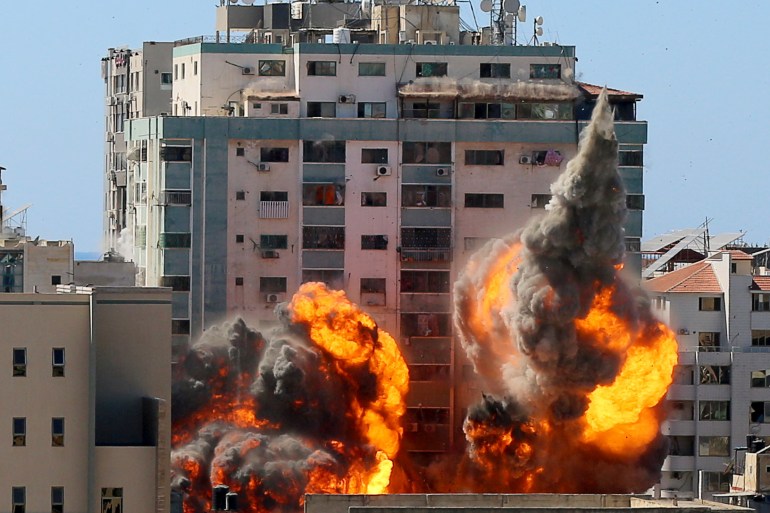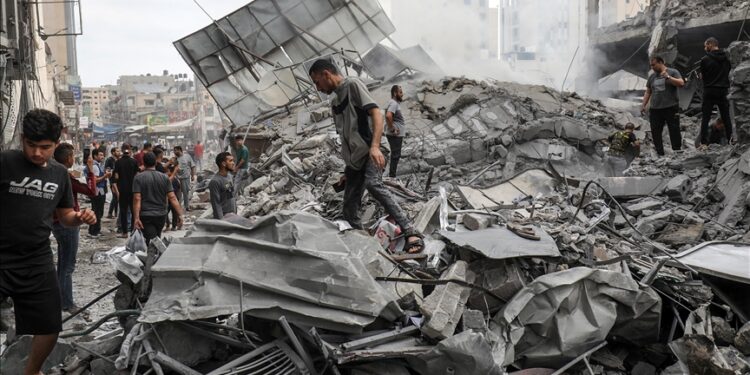The Israel-Palestine conflict has deep historical roots, with both sides claiming historical and religious connections to the land. The conflict can be traced back to the early 20th century, when Zionist Jews sought to establish a homeland in Palestine, which was under British control at the time. This led to tensions with the Arab population, who feared displacement and loss of their own rights. After the United Nations proposed a partition plan in 1947, violence erupted, leading to the 1948 Arab-Israeli War. Israel declared independence, and neighboring Arab countries intervened. The war resulted in displacement and loss of land for both Palestinians and Israelis. Subsequent conflicts, such as the Six-Day War in 1967 and the ongoing Israeli occupation of the West Bank and Gaza Strip, have further fueled the conflict. The situation remains complex and deeply rooted in historical, political, and religious factors.

Now introduction about Hamas:-
Hamas is an Islamist militant group that emerged from the Palestinian branch of the Muslim Brotherhood in the late 1980s. It gained control of the Gaza Strip after winning elections in 2006. Hamas is known for its armed resistance against Israel, which includes tactics like suicide bombings and rocket attacks. Due to its actions, the United States and European Union have designated Hamas as a terrorist organization. In 2023, Hamas launched a surprise attack on southern Israel, resulting in significant casualties and hostage situations. This attack has escalated tensions in the region and raised concerns about a wider conflict in the Middle East.
“Hamas-Israel Conflict: Unpacking the Goals and Implications”
The situation between Hamas and Israel is complex, and the goals of Hamas in launching attacks on Israel may not be solely about territorial gains or concessions in the traditional sense. Hamas, as an Islamist militant group, often operates with multiple objectives:
- Symbolic and Political Gain: Hamas may seek to gain political recognition and support among Palestinians by portraying itself as a defender of Palestinian rights. Its actions could be aimed at bolstering its position within the Palestinian territories and potentially in the broader Arab world.
- Pressure and Influence: By launching attacks and firing rockets, Hamas can exert pressure on Israel and potentially push for concessions, such as easing restrictions in Gaza or garnering international attention to the Palestinian cause.
- Solidifying Support: Hamas might also want to strengthen its standing among its core supporters. Showing resistance against Israel can rally support from its base.
- Propaganda and Perception: The conflict allows Hamas to shape the narrative and garner international sympathy for the Palestinian cause.
While the Yom Kippur War involved national armies and territorial disputes, the Hamas-Israel conflict is more asymmetrical. Hamas’ goals may be less about capturing territory and more about pursuing its political and ideological objectives. Whether Hamas will achieve these goals in the medium or long term is uncertain, but the conflict has long-lasting implications for the region and the Palestinian cause.
“Challenges to Israeli Security: Assessing the Impact of Recent Hamas Attack”
The recent coordinated attack by Hamas has indeed challenged Israel’s security model and raised questions about the effectiveness of deterrence in asymmetric conflicts. The situation highlights the complexity of the Israel-Palestine issue. To ensure its security, Israel may need to consider a combination of strategies, including diplomacy, addressing the root causes of the conflict, and potentially seeking regional cooperation.
Hamas’s attack has brought the Palestine issue back into the spotlight of West Asian geopolitics. However, the use of such tactics, including targeting Israeli civilians, comes with significant risks and international pressure on its backers. Israel is likely to respond with a ground offensive and air strikes. The outcome will depend on various factors, including the capabilities and resilience of Hamas in the Gaza Strip and potential international mediation efforts.
Why did Hamas launched a surprise attack on Israel?
Certainly, the Israeli-Palestinian conflict is a deeply rooted and multifaceted issue with historical, political, religious, and cultural dimensions. To elaborate on some of the key factors at play:
- Historical Background: The conflict has its roots in the late 19th and early 20th centuries when both Jews and Arabs laid claims to the land, then part of the Ottoman Empire. It intensified after World War II and the Holocaust, leading to the establishment of Israel in 1948. This led to the displacement of hundreds of thousands of Palestinian Arabs, creating a long-standing refugee issue.
- Territory and Borders: One of the central issues is the territory and borders. Israel and the Palestinians both lay claim to the same land, particularly in East Jerusalem, the West Bank, and the Gaza Strip. The status of these areas, the rights of their inhabitants, and the borders of a potential Palestinian state are significant points of contention.
- Security Concerns: Israel has legitimate security concerns due to past conflicts, rocket attacks, and threats from various Palestinian groups. These concerns have led to military actions and a blockade on Gaza.
- Settlements: Israeli settlements in the West Bank have been a contentious issue. Many in the international community consider them illegal under international law, while Israel views them differently. These settlements complicate the potential for a two-state solution.
- Jerusalem: Jerusalem holds immense religious and symbolic significance for both Israelis and Palestinians. Determining its status, particularly with regard to holy sites, is a major challenge.
- Refugees: The issue of Palestinian refugees and their right to return to their ancestral homes is a significant point of contention. It’s a deeply emotional and unresolved issue for many Palestinians.
- Lack of a Peace Process: Over the years, attempts at peace negotiations have been made, but these have often broken down due to mistrust, differing interpretations of agreements, and changes in leadership on both sides.
- International Involvement: The Israel-Palestine conflict has garnered significant international attention and involvement, with various countries and organizations attempting to mediate and find a solution.
- Public Sentiment and Radical Groups: Public sentiment on both sides can be deeply polarized, and radical groups, such as Hamas on the Palestinian side, reject the existence of Israel, further complicating the peace process.
- Regional Dynamics: The broader Middle East context, including relationships with neighboring countries, has a significant impact on the conflict.

Elaborating on these factors demonstrates the complexity of the situation, and any lasting resolution would require addressing these issues comprehensively. A two-state solution, with secure borders for both Israel and a viable, independent Palestinian state, has been a long-standing goal, but achieving this remains a formidable challenge. Diplomacy, trust-building, and addressing the core concerns of both parties are essential for any potential peace settlement.
Divisions in Israeli society
The divisions within Israeli society are indeed a significant factor in the current state of affairs. The Israeli political landscape has seen a rise in right-wing and nationalist sentiments in recent years, which has resulted in a government with a more conservative and assertive agenda.
The efforts to overhaul the power structures in Israel, including curbing the judiciary’s powers, have led to domestic protests and internal discontent. These actions have sparked demonstrations and raised concerns about the balance of power within the country. The involvement of military reservists and their threat to resign in protest demonstrates the depth of disagreement within Israeli society regarding the government’s policies.
These internal divisions, along with concerns about civil rights and democratic principles, can be seen as a potential vulnerability for the Israeli government. Hamas might have perceived this internal strife as an opportunity to launch a significant attack from Gaza and potentially exploit the divisions within Israeli society to further its own goals. The situation underscores the complexity of the regional dynamics and the interconnected nature of domestic politics, security, and the Israel-Palestine conflict.
The Geopolitical angle
The geopolitical angle is an essential aspect of the current situation in the Middle East. The timing of the Hamas attack amid the normalization talks between Israel and Saudi Arabia is indeed noteworthy. The potential normalization of relations between Saudi Arabia, a major regional power, and Israel could have significant repercussions for the broader Middle East.

If such a normalization deal were to be achieved, it would not only reshape the geopolitical dynamics in the region but also have implications for various regional actors. Hamas, which has traditionally received support from Iran and is in conflict with Israel, could find itself in a more challenging position. The normalization of ties between Saudi Arabia and Israel could isolate and weaken groups like Hamas, especially if it is accompanied by a broader regional alignment with Arab states recognizing Israel.
Iran and Hezbollah, both of which have been staunch opponents of Israel, have a vested interest in preventing such normalization and would likely support any efforts that challenge it. The alignment of these actors adds to the complexity of the situation and can contribute to ongoing tensions and conflicts in the region.
The Biden administration’s active pursuit of regional normalization efforts is an important diplomatic development. However, the recent violence and the expected Israeli response could complicate the prospects for an immediate normalization deal between Saudi Arabia and Israel. The situation underscores the delicate and interconnected nature of Middle Eastern geopolitics, with multiple regional powers and interests at play.
In conclusion, the recent Hamas attack on Israel and the subsequent security crisis in the region underscore the intricate and interconnected nature of the Israel-Palestine conflict, marked by several key factors.
First, the deteriorating relations between Israelis and Palestinians, the lack of a viable peace process, and the ongoing tensions have contributed to the deep-seated grievances on both sides. The conflict remains multifaceted and rooted in historical, territorial, and security concerns.
Second, divisions within Israeli society, including political, legislative, and civil rights disputes, have created internal vulnerabilities. These domestic issues may have been perceived by Hamas as an opportunity to launch an unprecedented attack.
Lastly, the geopolitical context plays a significant role, with the timing of the attack coinciding with ongoing normalization talks between Israel and Saudi Arabia. A potential normalization agreement could have far-reaching implications for regional dynamics, potentially isolating groups like Hamas, while drawing opposition from Iran and Hezbollah.
The complex interplay of these factors contributes to the ongoing volatility in the Middle East. Achieving lasting peace in the region requires addressing these multifaceted issues comprehensively, and navigating the intricate geopolitics in the region is a significant challenge. The recent events highlight the pressing need for continued international efforts to de-escalate tensions, promote dialogue, and work towards a peaceful resolution to the Israel-Palestine conflict.



